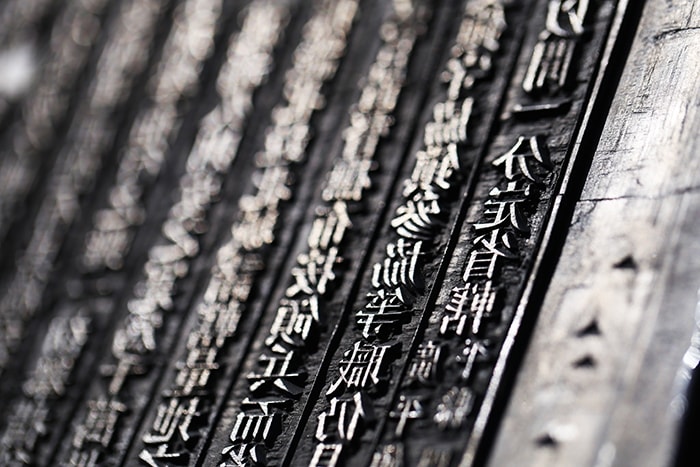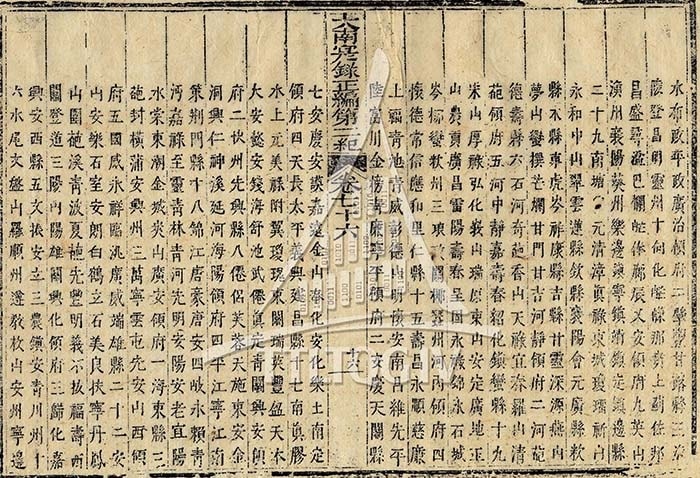Hai Duong through Nguyen dynasty woodblocks. Part 2: Birth of "Hai Duong province" name
Culture - Sports - Tourism - PublishedTime : 08:09, 17/04/2021
Part 1: Imprints of ancient land

Dong Mon gate of the ancient Thanh Dong
Under the Nguyen dynasty, Hai Duong was a vast land holding an important strategic position in the overall development of the country.
After national pacification and reunification, King Gia Long returned Kinh Mon phu (a past administrative unit more important than a district) to Hai Duong tran (province).
Thus, under the reign of the first king of the Nguyen dynasty, the name Hai Duong tran continued to be used. At that time, Hai Duong tran consisted of one phu, one district, and five chau (mountainous district).
In Minh Mang time, the king changed Thuong Hong phu of Hai Duong tran to Binh Giang phu, Ha Hong phu to Ninh Giang phu in Nham Ngo year (1822).
In Tan Mao year (1831), to unify administrative units in the country, the second king of the Nguyen dynasty ordered the large-scale administrative reform of switching dinh (province) and tran to tinh (province).
The reform was divided into two phases. The first one was carried out in Tan Mao year. King Minh Mang divided tran from Quang Tri to the North into 18 provinces, including Hai Duong.
The second phase took place in Nham Thin year (1832) with King Minh Mang splitting the remaining tran and doanh (province) from Quang Nam to the South.
The 15th and 16th woodblocks of the 76th volume of the 2nd annal of the book Dai Nam Thuc Luc Chinh Bien (Principal Section of the Veritable Records of Dai Nam) record the second king's arrangement of Hai Duong province as follows: "The territory of provinces was separated. Hai Duong ruled four phu of Binh Giang, Ninh Giang, Nam Sach, and Kinh Mon and 18 districts of Cam Giang, Duong Hao, Duong An, Tu Ky, Vinh Lai, Thanh Mien, Gia Loc, Chi Linh, Thanh Lam, Thanh Ha, Tien Minh, An Duong, An Lao, Nghi Duong, Thuy Duong, Dong Trieu, Kim Thanh, and Giap Son... Later, Hai Duong had its own name Dong (Eastern) province."

The 19th woodblock of the 17th volume of the 1st annal of the book Dai Nam Thuc Luc Chinh Bien records the name Hai Duong tran with four phu and 18 districts under the reign of King Gia Long. Source: The National Archives Center IV
Hence, according to Nguyen dynasty woodblocks, Tan Mao year (1831) was the time the name "Hai Duong province" appeared. This is considered an important milestone marking the continuous development of Hai Duong in history. The year 1831 is considered the time Hai Duong had a complete governmental apparatus of a Centrally-run administrative unit.
One year later (i.e. Nham Thin year – 1832), the king added Ninh Giang sub-phu, consisting of Thanh Mien and Gia Loc districts, and Nam Sach sub-phu, governing Thanh Ha and Tien Minh districts.
In Dinh Dau year (1837), King Minh Mang added Kien Thuy phu.
The 31st woodblock of the 36th volume of the book Kham Dinh Dai Nam Hoi Dien Su Le (Compendium of Institutions and Administrative Cases of Dai Nam Established by Imperial Order) also records: "In the 18th year (1837), Kien Thuy phu was added (split from Kinh Mon phu) with two districts of Nghi Duong and An Duong. Kien Thuy sub-phu received Kim Thanh and An Lao districts."
At the request of Governor Nguyen Cong Tru, the second king of the Nguyen dynasty added Vinh Bao district one year later, i.e. Mau Tuat year (1838): "In the 19th year (1838), Vinh Bao district was added (split from Tu Ky and Vinh Lai districts) but still belonged to Ninh Giang phu. Besides, Thanh Mien district was transferred to Binh Giang phu. In addition, Binh Giang sub-phu was created and got two districts of Cam Giang and Thanh Mien."
Under the reign of Kings Thieu Tri and Tu Duc, most of the administrative boundary of Hai Duong province remained unchanged from Minh Mang time.
In Canh Dan year (1890), King Thanh Thai formed new provinces in the North.
Article 0165 of the 6th annal (supplemental one) of the book Dai Nam Thuc Luc Chinh Bien records: "New provinces were created in the North. Additionally, My Duc and Chuong My districts and Phuong Lam province were merged into My Duc dao(province), and four districts of My Hao, An My, Van Lam, and Cam Luong were taken from Hai Duong, Hung Yen, and Bac Ninh counties to form Dich Lam dao."

The 15th and 16th woodblocks of the 76th volume of the 2nd annal of the book Dai Nam Thuc Luc Chinh Bien record King Minh Mang's arrangement of Hai Duong province in Tan Mao year (1821). Source: The National Archives Center IV
In the same year, the king placed Dong Trieu dao in the North. Dong Trieu district, three tong (an intermediary administrative unit between a district and a commune) of Thuy Nguyen district, and four tong of Chi Linh district, Hai Duong province, were divided into three districts of Dong Trieu, Chi Linh, and Truc Dong, forming a dao with the administrative center located in Kinh Trieu commune.
In Binh Than year (1896), King Thanh Thai divided Thanh Mien district, deducted nine tong and 67 communes and hamlets originally belonging to Thanh Mien district, situated the administrative center of the district in Tho Truong commune, arranged mandarins, and detached a garrison.
The district was originally administrated by Binh Giang phu. Its administrative center was set up in the 2nd month of the 2nd Thanh Thai year, and it was merged into Ninh Giang phu in the 4th month of the 5th year but the population was scattered, public affairs were delayed, etc., so it was reorganized.
Through historical ups and downs with many other times of division and mergence, on November 6, 1996, Hai Duong province was re-established from Hai Hung province. Upon separation, Hai Duong province had nine administrative units, consisting of Hai Duong town and eight districts.
It can be said that over the past 190 years since Tan Mao year (1831), the name "Hai Duong province" has always been stably used and present on the map of Vietnam, and in the development process of Hai Duong province, the woodblocks of the Nguyen dynasty – a Memory of the World recording the formation and development of the province always are valuable and must-read property for those wanting to learn about this heroic land.
THOM QUANG
